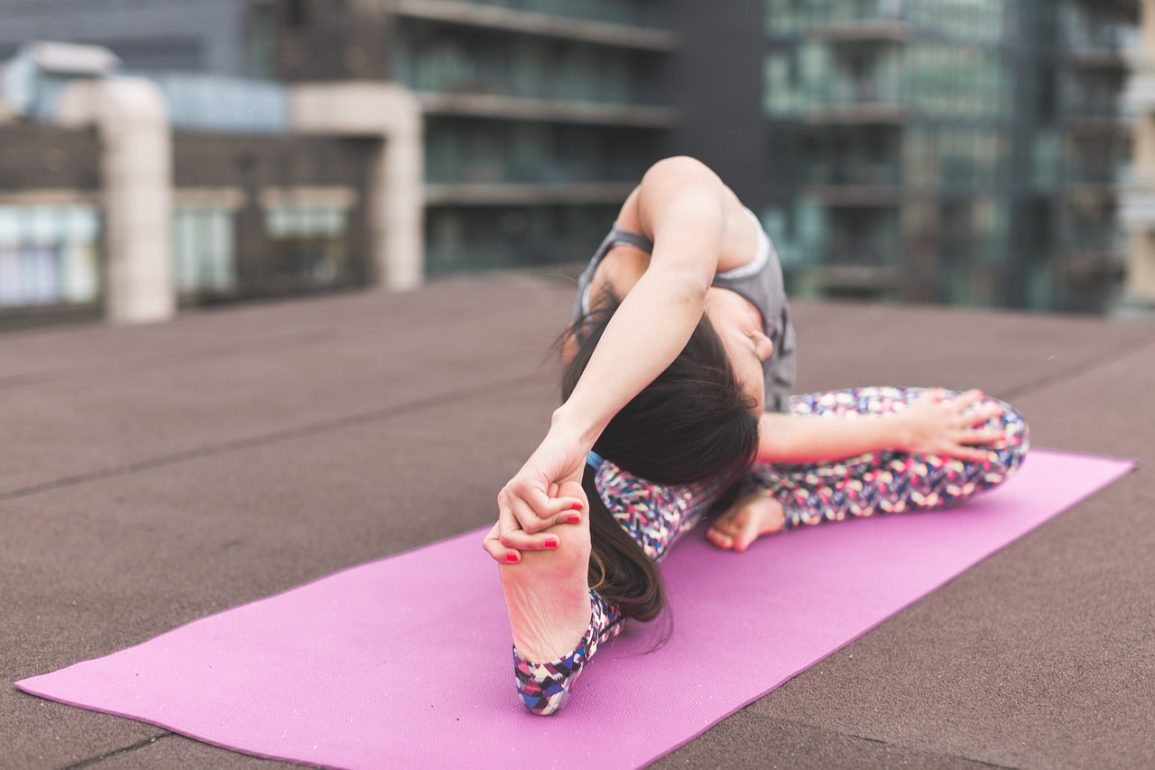The Benefits of Incorporating Yoga into Your Daily Routine: 6 Top Wellness Perks.
Did you know that incorporating yoga and relaxation techniques into your daily routine through regular practice can do wonders for your overall well-being and personal growth? That’s right, yoga offers a wide range of health benefits beyond physical fitness and exercise.
For starters, it helps boost mental clarity, making you more focused and sharper throughout the day. In addition to the physical benefits of exercise, practising yoga regularly can improve your mental health and contribute to personal growth through relaxation techniques. It’s no secret that stress takes a toll on our bodies and minds, but with yoga on your side, you’ll be better equipped to handle life’s ups and downs. So why wait? Start reaping the benefits of this ancient practice today and watch as it transforms your life for the better!
Integrating Yoga into Everyday Life
Morning Routine for Energy Boost
Kickstart your day with yoga and relaxation techniques that wake up your body and mind. Incorporating exercise like yoga into your daily routine can provide physical benefits, helping you feel energised and ready to tackle the day ahead. Morning yoga poses include:
- Sun Salutations (Surya Namaskar)
- Downward Facing Dog (Adho Mukha Svanasana)
- Warrior Poses (Virabhadrasana)
These yoga philosophy-inspired poses in your yoga class not only stretch and strengthen your muscles but also promote mindfulness and relaxation techniques, setting a positive tone for the rest of the day while improving posture.
Lunchtime Practice to Refocus
Taking a break from work during lunchtime is essential for maintaining productivity throughout the day. Practising relaxation techniques, such as a short yoga session, can help you refocus and recharge while also improving digestion after eating. Some top yoga poses include:
- Seated Forward Bend (Paschimottanasana)
- Half Lord of the Fishes Pose (Ardha Matsyendrasana)
- Camel Pose (Ustrasana)
By integrating these yoga poses and relaxation techniques into your lunchtime routine, you can experience increased mental clarity and reduced stress levels in your daily life. Embracing the yoga philosophy through regular practice will further enhance these benefits.
Evening Relaxation and Stress Relief
After a long day at work, practising relaxation techniques like yoga in the evening with a personal trainer can help release tension from both the body and mind. Regular training during this time of day supports proper posture and inner peace by providing an opportunity to let go of accumulated stressors from throughout the day.
Some soothing evening asanas include:
- Legs-Up-The-Wall Pose (Viparita Karani)
- Child’s Pose (Balasana)
- Corpse Pose (Savasana)
In addition to the regular practice of yoga poses during your yoga class or with a personal trainer, incorporating meditation or deep breathing exercises in your evening routine further promotes tranquillity.
- Manage Stress Effectively with Yoga Techniques
- Utilising Yoga Techniques in Daily Life Situations
- Yoga offers various techniques that can be applied to daily life situations, helping to reduce stress, and anxiety, and improve sleep quality. Some examples include:
Breathing exercises: Practising deep breathing techniques like pranayama can calm the nervous system and lower blood pressure.
Meditation: Taking a few minutes each day for mindfulness meditation can enhance mental clarity and focus.
Physical postures: Incorporating yoga poses (asanas) throughout the day can relieve tension in the body and promote relaxation.
By integrating these practices into your everyday life, you’ll be better equipped to handle stressful situations with ease.

Deep Breathing Exercises (Pranayama)
One of the essential techniques in yoga for self-relaxation and managing stress is deep breathing exercises, also known as Pranayama. These breathing techniques help calm the mind and body by regulating the breath, promoting relaxation. Some popular Pranayama practices for self-relaxation include:
Ujjayi Breath: Also known as the “victorious breath,” this technique involves inhaling and exhaling through the nose while slightly constricting the back of your throat.
Nadi Shodhana: Commonly referred to as alternate nostril breathing, this practice helps balance both sides of your brain and promotes relaxation.
Kapalabhati: Known as “skull-shining breath,” this technique consists of short, forceful exhales followed by passive inhales.
By incorporating yoga classes and self-relaxation techniques into your daily routine, you can effectively reduce stress levels and improve overall well-being.
Mindful Meditation Practices
Another way to manage self-induced stress with yoga is through mindful meditation practices. These practices help bring self-awareness to your thoughts and emotions without judgement, allowing you to stay present in each moment. Some simple meditation techniques for self-improvement include.
Body Scan Meditation: This practice encourages you to focus on different parts of your body sequentially, bringing awareness to any tension or discomfort.
Loving-kindness Meditation: Also known as Metta meditation, this technique involves silently repeating phrases of love and compassion towards yourself and others.
Breath Awareness Meditation: This practice focuses on observing your natural breath without trying to change or control it.
Incorporating mindful meditation into your daily self-care routine can significantly reduce anxiety levels and promote mental clarity.
Restorative Yoga Poses
Self-restorative yoga poses are designed to promote relaxation by gently stretching the body while using props for support. These self-restorative poses allow you to release tension in both muscles and connective tissues while calming the nervous system. Some self-restorative yoga poses to help manage stress include:
- Child’s Pose (Balasana): This pose gently stretches the lower back and hips, promoting relaxation.
- Legs-Up-The-Wall Pose (Viparita Karani): By elevating your legs, this pose helps reduce fatigue and relieve tension in the lower back.
- Supported Bridge Pose (Setu Bandha Sarvangasana): Using a block or bolster under your sacrum, this pose gently opens the chest and spine while relieving tension in the neck and shoulders.
By integrating restorative yoga poses into your daily routine, you can effectively combat stress and improve overall mental health.
Developing a Consistent Self-Care Routine
Establishing a consistent self-care routine is essential for managing stress levels effectively. Here are some tips on how to create a sustainable yoga practice:
Set aside time: Dedicate at least 10-15 minutes per day for yoga practice – even short sessions can make a significant impact on mental well-being.
Prioritise consistency: Aim to practise at the same time every day, creating a habit that becomes second nature.
Choose appropriate techniques: Select yoga methods suited to your needs – whether it’s calming breathwork or energising asanas.
Listen to your body: Pay attention to how you feel during practice and adjust accordingly – remember that self-care should be nurturing rather than straining.
Building Strength, Balance, Flexibility
Core-strengthening Asanas
Incorporating yoga into your daily routine offers numerous benefits, one of which is building strength through core-strengthening asanas (poses). A strong core is essential for proper posture and overall physical health. Some effective core-strengthening poses include:
- Boat Pose (Navasana)
- Plank Pose (Kumbhakasana)
- Side Plank Pose (Vasisthasana)
These poses engage and strengthen the muscles in your abdomen, back, and pelvis, promoting stability and balance throughout your body.
Improved Posture through Alignment Awareness
Yoga goes beyond mere exercise or training; it’s a journey of personal growth that encourages you to become more aware of your body’s alignment. This awareness helps improve your posture by teaching you how to maintain a neutral spine during various movements. For instance, a personal trainer might instruct you to perform the following poses:
- Mountain Pose (Tadasana)
- Tree Pose (Vrksasana)
- Warrior I & II Poses (Virabhadrasana I & II)
By practising these poses regularly, you’ll develop an understanding of proper alignment and gradually correct any imbalances or misalignments in your body.
Increased Range of Motion from Stretching
One major benefit of incorporating yoga into your daily routine is increased flexibility due to regular stretching. Yoga poses often involve deep stretches that target specific muscle groups, helping release tension and tightness. This increased range of motion not only makes everyday activities easier but also reduces the risk of injury during other forms of exercise.
Some examples of yoga stretch that promote flexibility are:
- Downward-Facing Dog (Adho Mukha Svanasana) – Stretches hamstrings and calves.
- Pigeon Pose (Eka Pada Rajakapotasana) – Stretches hips and glutes.
- Seated Forward Bend (Paschimottanasana) – Stretches the entire backside of the body, from the calves to the upper back.
By incorporating these stretches into your daily routine, you’ll notice improvements in your flexibility and overall physical well-being.
Alleviate Back Pain with Regular Yoga Practice
Gentle Spinal Twists for Mobility
Incorporating regular yoga practice into your daily routine can help alleviate back pain by improving spinal mobility. Gentle spinal twists are an excellent way to achieve this, as they stretch and strengthen the muscles surrounding the spine. Here is a few simple yoga poses that incorporate gentle spinal twists:
Seated Spinal Twist: Sit on the floor with both legs extended in front of you. Bend your right knee and cross it over your left leg, planting your foot on the floor outside your left thigh. Twist your torso to the right, placing your left elbow against the outside of your right knee.
Supine Spinal Twist: Lie down on your back with both knees bent and feet flat on the floor. Slowly lower both knees to one side while keeping your shoulders flat on the ground and looking in the opposite direction.
Chair Twist: Sit sideways on a chair with your right hip against its backrest. Hold onto the backrest with both hands and twist towards it, using it as leverage to deepen the stretch.
Consult an experienced practitioner before attempting new yoga poses, especially if you have pre-existing health conditions or concerns.
Strengthening Lower Back Muscles
Regular yoga practice can also help alleviate back pain by strengthening lower back muscles. A strong lower back provides better support for our spine, reducing pressure on intervertebral discs and nerves. Some effective yoga poses for strengthening lower back muscles include:
Cat-Cow Pose: Begin in a tabletop position (on all fours) with hands under shoulders and knees under hips. Inhale as you arch your spine downward (cow pose) and exhale as you round it upward (cat pose), moving fluidly between these two positions.
Bird-Dog Pose: From a tabletop position, extend one arm forward while simultaneously lifting and extending the opposite leg behind you. Hold for a few breaths, then switch sides.
Locust Pose: Lie face down on your mat with arms alongside your body and palms facing up. Lift your chest, arms, and legs off the ground simultaneously, engaging your lower back muscles as you hold the pose.
Lengthening Hamstrings to Reduce Pressure
Tight hamstrings can contribute to back pain by causing an anterior pelvic tilt, which increases pressure on the lumbar spine. Regular yoga practice can help lengthen hamstrings and alleviate this pressure. Some effective hamstring-stretching yoga poses include:
Downward-Facing Dog: Begin in a plank position (top of a push-up) with hands shoulder-width apart and feet hip-width apart. Push your hips upward while straightening your legs and pressing your heels toward the floor, creating an inverted V shape with your body.
Forward Fold: Stand tall with feet hip-width apart. Slowly bend forward from the hips, keeping legs straight or slightly bent if needed. Reach towards the floor or grasp opposite elbows to deepen the stretch.
Reclined Hand-to-Big-Toe Pose: Lie on your back with both legs extended in front of you. Loop a strap around one foot’s arch and slowly lift that leg into the air while keeping it straight, using the strap to guide its movement.
Connecting with Yoga Community
Joining Local Classes or Workshops
One of the significant benefits of incorporating yoga into your daily routine is connecting with a supportive and like-minded community. By attending local yoga classes and workshops, you’ll have the opportunity to:
- Learn from experienced yoga teachers.
- Improve your yoga poses and techniques.
- Meet new friends who share your passion for yoga.
- Stay motivated and accountable in your practice.
- Engaging in Online Forums and Social Media Groups.
In today’s digital age, it’s easier than ever to connect with fellow yogis from around the world. Online forums, social media groups, and apps dedicated to yoga provide a platform for:
- Sharing tips, advice, and experiences
- Asking questions or seeking guidance
- Discovering new styles of yoga or unique approaches to specific poses
- Staying up to date on events happening in the global yoga community
- Participating in Yoga Retreats or Events
Yoga retreats offer an immersive experience that combines relaxation, connection, and personal growth. Some benefits of attending a retreat include:
- Deepening your practice through daily classes led by experienced teachers.
- Exploring new styles of yoga or learning about related topics (e.g., meditation)
- Forming strong bonds with fellow participants who share similar values and interests.
- Enjoying downtime for self-reflection, relaxation, or adventure
- Embrace Healthier Lifestyle
Incorporating yoga into your daily routine offers numerous health benefits. It helps you manage stress effectively, and build strength, balance, and flexibility while alleviating back pain. By practising yoga regularly, you can connect with the yoga community and embrace a healthier lifestyle.
Don’t miss out on these amazing benefits! Start integrating yoga into your everyday life today and experience the positive changes it brings to your physical and mental well-being. Remember, consistency is key – so make it a habit and watch yourself transform.
Poppy Watt


